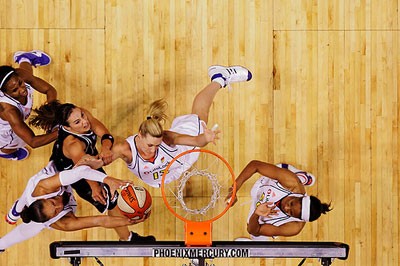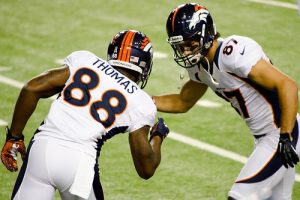The business of sports is going beyond game coverage and box scores and delving into the financial operations of professional teams, universities and non-profit organizations, which operate amateur athletic events, college booster clubs and college football bowls.
Covering sports business can be a significant beat in a sports Mecca like metro-Phoenix, where (so far) there are teams in all four major sports leagues along with Arizona State University, the Cactus League, NASCAR and the WNBA.
Sports business coverage, however, also can be done in a town where college sports is king and there isn’t a professional franchise within miles. And the beat can produce in-depth, investigative stories in small towns where high school coverage is the franchise of the sports page.
And it’s not limited to daily journalism. One of the best sports business reporters in the country is Darren Rovell of CNBC. Rovell previously worked for ESPN.com, and his ability to understand sports and business opened the door to write two outstanding business books: “First In Thirst: How Gatorade Turned The Science of Sweat Into A Cultural Phenomenon” and “On the Ball: What You Can Learn About Business From America’s Sports Leaders.” In “First in Thirst,” Rovell provides intricate details of how Gatorade was created, and he provided a behind-the-scenes look into one of the biggest brands in sports.
BE NICE TO RUTHIE
Regardless of the market, the key to covering this beat is getting to know the “movers and shakers” of the sports community – along with their assistants.
If you were genuinely nice to Ruthie, she would make sure Colangelo got back to you, especially if you were on deadline.In Phoenix, one of the top sports executives for many years was Jerry Colangelo, the former managing partner of the Phoenix Suns and Arizona Diamondbacks. While Colangelo was one of the most accessible sports executives in the country, you could guarantee he would call you back if you had a good relationship with his longtime assistant, Ruthie, who often screened his calls.
TRACKING MINORITY PARTNERS
You can also develop interesting feature stories by finding out the names of minority owners in professional sports teams.
For example, Jenny Craig, the namesake of the international weight loss company, is a minority owner of the Phoenix Suns. Mike Chipman, who founded a company that developed TurboTax, is a minority investor in the Arizona Diamondbacks but keeps a low profile.
It’s also important to gather and review as many public records as possible to develop stories. Of course, professional sports teams are privately held, but their owners could hold large stakes in publicly held companies whose financial reports are available through SEC.gov.
Those records could show whether an owner truly is deep pocketed or leveraged, and you can find related-part transactions, a business deal or arrangement between two parties who are joined by a special relationship prior to a deal. And that relationship may not necessarily benefit shareholders.
TAPPING THE GOLDEN GOOSE
For example, until Howard Schultz sold the Seattle Sonics to Oklahoma City investors in 2006, the Starbucks founder had his coffee company spend $3.7 million during the course of four years on sponsorships for his NBA team. The sponsorships were a fraction of annual revenues for Starbucks, but the deal showed how one person’s successful business (Starbucks) was helping a business (Sonics) that was bleeding money.
Interestingly, the sponsorships ended as soon as Schultz sold the team, a move Starbucks said was coincidental. The information regarding the business arrangement was disclosed in a proxy filing that Starbucks had made with the Securities and Exchange Commission.
MAKE FRIENDS WITH SEC FILINGS
Securities and Exchange Filings also can inform you about sports business relationships. Consider: Robert Sarver is the majority owner of the NBA’s Phoenix Suns, and he’s the chairman and chief executive of the publicly held Western Alliance Bancorporation. One of the members of that board is George Maloof Jr., who is an owner of the NBA’s Sacramento Kings. Sarver has complained publicly about the Suns losing money, while the Maloof family has threatened to move the Kings from California’s capital because of financial problems.
As the NBA continues its lockout, it will be interesting to see if Sarver and the Maloofs are part of an alignment among owners in the lockout and labor negotiations with players.

PUBLIC RECORDS
In covering a public university, the athletic department’s entire budget along with all coaches’ salaries – and perks – are public record, and they can be obtained by filing a public records request. Be sure to ask for all outside contracts, such as those with apparel companies that may significantly boost a coach’s compensation. And, be prepared for a fight as many schools don’t like to disclose this information.
A number of years ago, the University of Arizona refused to disclose a contract then head basketball coach Lute Olson had with Nike, saying it was a private deal. The money, however, from Nike flowed through the university, which made the deal public and available through a public records request. To get the contract, I appealed to the Arizona Board of Regents, which runs the university system. The regents forced UA to turn over the Nike contract.
Also, get the contracts of peer coaches at other conference schools in order to have context and a fair comparison to what your coach is making.
NON-PROFIT DATA
Another great resource for sports business stories is GuideStar.org, which has annual financial records for more than 1 million non-profit organizations.
Non-profits run college football bowls, booster clubs for universities and colleges, state athletic associations (governing bodies for high school sports) and high school club teams. These records will show the revenues and expenses of each organization in addition to the salaries of top employees and independent contractors. See the “glossary and localize” sections for more information and how to develop a sports business story from these records.










